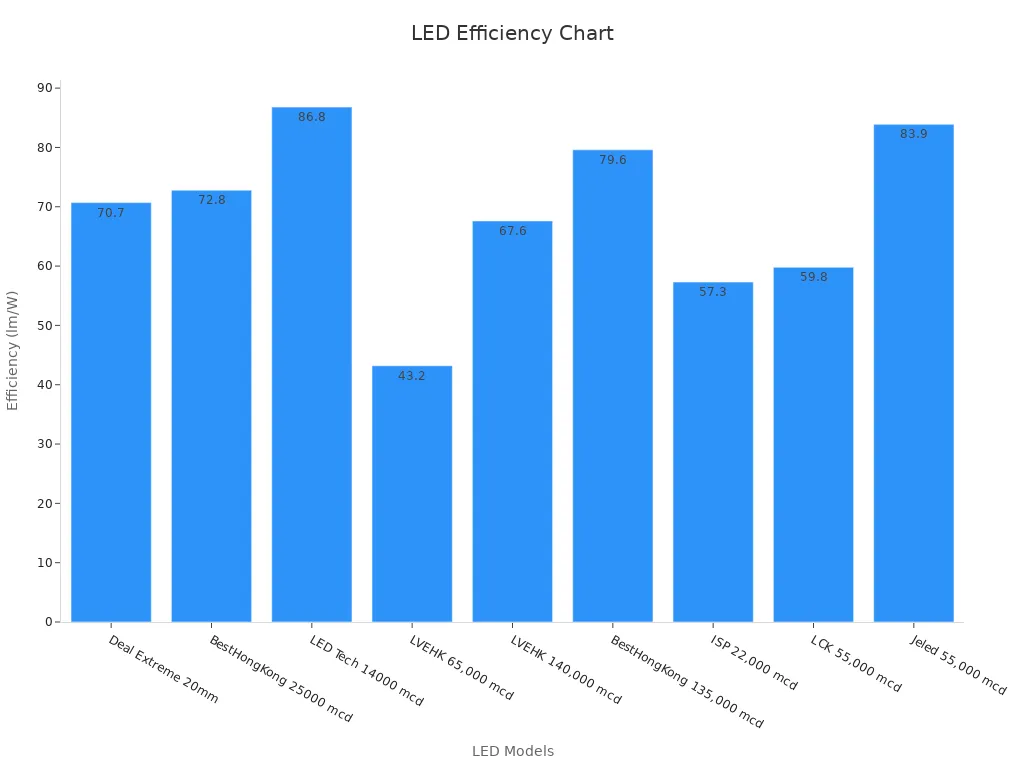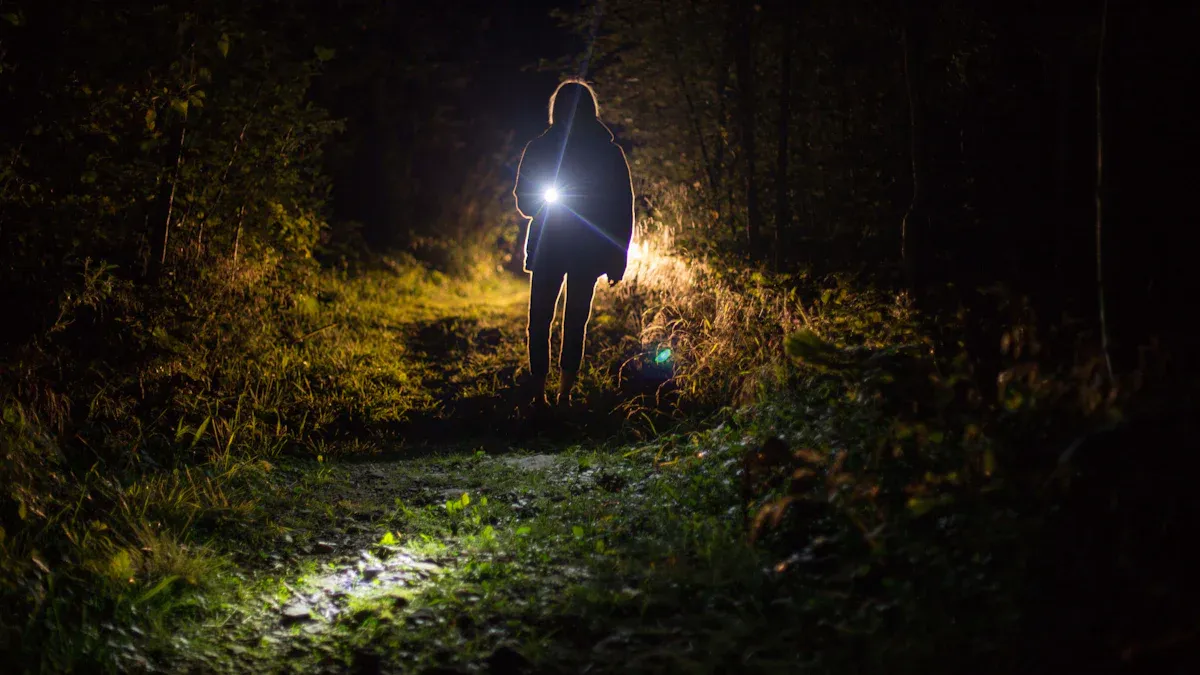The lumen-to-runtime ratio plays a pivotal role in determining the performance of tactical flashlights. This balance ensures that users can rely on their flashlight for extended periods without compromising brightness. For outdoor enthusiasts, a flashlight with 500 lumens and a beam distance of 140 meters provides excellent visibility during nighttime activities. In emergencies, a runtime of 1.5 hours on high settings offers dependable illumination. Tactical flashlight specs, such as waterproof ratings like IPX7, further enhance reliability in challenging conditions, making these tools indispensable for self-defense, search operations, and camping.
Key Takeaways
- Pick a flashlight with 500 lumens or more for clear outdoor views.
- Go for rechargeable batteries to make them last longer and save money.
- Adjust brightness levels to save battery and match your needs.
- Think about weather like heat or moisture to keep it working well.
- Take care of your flashlight by cleaning it and storing batteries safely.
Key Concepts: Lumens, Runtime, and Tactical Flashlight Specs

What Are Lumens and Why Are They Important?
Lumens measure the total visible light emitted by a flashlight. This unit directly correlates with brightness, making it a critical factor in tactical flashlight performance. A flashlight with higher lumens produces a brighter beam, which is essential for tasks requiring enhanced visibility. For instance, tactical applications often demand a minimum of 500 lumens, while search and rescue operations may require outputs exceeding 1000 lumens.
Different lumen ranges serve various purposes:
- Less than 150 lumens: Suitable for reading or as a night light.
- 150-500 lumens: Ideal for everyday tasks and DIY projects.
- 500-1000 lumens: Perfect for outdoor activities like camping or hiking.
- Over 3000 lumens: Designed for professional use, such as hunting or law enforcement.
A tactical flashlight with 1000 lumens can illuminate vast areas, making it indispensable for outdoor enthusiasts and professionals alike.
Understanding Runtime and Its Impact on Performance
Runtime refers to the duration a flashlight operates before its battery depletes. This specification significantly impacts the flashlight’s reliability, especially in critical situations. For example, a flashlight with a runtime of 1.5 hours on high settings ensures dependable illumination during emergencies.
Battery type and capacity influence runtime. Rechargeable options, such as 18650 lithium-ion batteries, offer extended usage compared to traditional alkaline batteries. Advanced lighting technology, like high-efficiency LEDs, further optimizes runtime without compromising brightness.
How Tactical Flashlight Specs Influence the Lumen-to-Runtime Ratio
Tactical flashlight specs determine the balance between brightness and runtime. Features like adjustable brightness modes allow users to conserve battery life by switching to lower settings when maximum brightness is unnecessary. Additionally, water-resistant designs, such as those with an IP67 rating, ensure consistent performance in challenging environments.
Performance tests reveal that specifications like battery type and LED efficiency directly affect the lumen-to-runtime ratio. For instance, a flashlight powered by a 14500 battery may achieve higher brightness but shorter runtime compared to one using an AA battery. These insights highlight the importance of selecting tactical flashlight specs tailored to specific needs.
Factors Influencing the Lumen-to-Runtime Ratio
Battery Capacity and Rechargeable Options
Battery capacity plays a crucial role in determining the runtime of tactical flashlights. Rechargeable lithium-ion batteries, such as the 18650 model, have revolutionized the market by offering extended runtimes and faster charging capabilities. These batteries are not only cost-effective but also environmentally friendly, making them a preferred choice for both professionals and outdoor enthusiasts.
The growing popularity of rechargeable flashlights stems from their convenience and reliability. For instance, a flashlight powered by a rechargeable battery can sustain high brightness levels for longer periods compared to traditional alkaline batteries. This advancement ensures that users can rely on their flashlight during extended missions or emergencies without frequent battery replacements.
LED Efficiency and Advanced Lighting Technology
The efficiency of LEDs directly impacts the lumen-to-runtime ratio. Modern tactical flashlights utilize advanced LEDs that maximize brightness while minimizing energy consumption. Laboratory tests reveal significant differences in LED efficiency, as shown in the table below:
| LED Model | Lumen Output | Efficiency (lm/W) | Beam Angle | Color Temperature |
|---|---|---|---|---|
| Deal Extreme 20mm | 4.23 | 70.7 | 39.1° | 7000K |
| BestHongKong 25000 mcd | 16.41 | 72.8 | 34.7° | 7000K |
| LED Tech 14000 mcd | 20.06 | 86.8 | 77.1° | 7000K |

High-efficiency LEDs not only enhance brightness but also extend battery life. Tactical flashlight specs often include advanced lighting technology to ensure optimal performance in various conditions, from search and rescue operations to outdoor camping.
Adjustable Brightness Modes and Their Benefits
Flashlights with adjustable brightness modes offer significant advantages in optimizing the lumen-to-runtime ratio. These modes allow users to switch between high and low brightness settings based on their needs, conserving battery life when maximum brightness is unnecessary.
- Adjustable beams provide versatility, adapting to different environments and tasks.
- Long-lasting battery life ensures flashlights remain operational during extended use.
- Rechargeable options enhance convenience, allowing users to focus on their activities without worrying about battery depletion.
By incorporating adjustable modes, tactical flashlights achieve a balance between brightness and runtime, making them reliable tools for various applications.
Environmental Conditions and Their Effect on Runtime
Environmental conditions significantly influence the runtime of tactical flashlights. Factors such as temperature, humidity, and altitude can alter battery performance and LED efficiency, directly affecting the lumen-to-runtime ratio.
1. Temperature Extremes
Extreme temperatures, whether hot or cold, can reduce battery efficiency. Lithium-ion batteries, commonly used in tactical flashlights, perform optimally within a specific temperature range. In freezing conditions, chemical reactions inside the battery slow down, leading to shorter runtimes. Conversely, excessive heat can cause overheating, which may degrade battery components over time.
Tip: To maximize runtime in cold environments, users can keep their flashlight close to their body to maintain warmth. For hot climates, storing the flashlight in a shaded area helps prevent overheating.
2. Humidity Levels
High humidity can lead to condensation inside the flashlight, potentially damaging internal components. Although many tactical flashlights feature water-resistant designs, such as IP67 ratings, prolonged exposure to moisture may still impact performance. Dry conditions, on the other hand, pose less risk but may cause static buildup, which could interfere with electronic circuits.
3. Altitude Variations
At higher altitudes, reduced air pressure can affect the heat dissipation of LEDs. Poor heat management may lead to overheating, which can shorten the lifespan of both the LED and the battery. Flashlights designed with advanced thermal regulation systems are better equipped to handle such conditions.
Understanding these environmental factors allows users to adapt their flashlight usage accordingly. By taking preventive measures, they can ensure optimal performance and extend the runtime of their tactical flashlight in any situation.
Practical Tips for Optimizing Your Tactical Flashlight

Selecting the Right Flashlight for Your Needs
Choosing the ideal flashlight depends on its intended use. Tactical flashlight specs, such as output lumens, beam distance, and battery life, play a crucial role in determining suitability. For example, a flashlight with 500 lumens, a beam distance of 140 meters, and a runtime of 1 to 1.5 hours is perfect for outdoor activities or emergencies. Water resistance, like an IPX7 rating, ensures durability in wet conditions.
When selecting a flashlight, consider the following:
- Brightness: Higher lumens provide better visibility but may reduce runtime.
- Battery Type: Rechargeable lithium-ion batteries offer longer runtimes and are eco-friendly.
- Durability: Water-resistant and impact-resistant designs enhance reliability.
Professional evaluations and field tests ensure these features meet industry standards, making them reliable for various applications.
Using Adjustable Modes to Balance Brightness and Runtime
Adjustable brightness modes allow users to optimize performance based on their needs. High settings provide maximum illumination, while lower modes conserve battery life. This flexibility is essential for tasks requiring prolonged use, such as camping or search operations.
For example, a flashlight with multiple modes can adapt to different scenarios:
- High Mode: Ideal for emergencies or long-distance visibility.
- Medium Mode: Suitable for general outdoor activities.
- Low Mode: Perfect for conserving battery during extended use.
Switching between modes ensures a balance between brightness and runtime, enhancing the flashlight’s efficiency.
Maintaining Batteries and Flashlight Components
Proper maintenance extends the lifespan of both batteries and flashlight components. Storing batteries in a cool, dry place prevents damage from extreme temperatures. For rechargeable batteries, partial charging (30%-50%) during storage maintains their health.
Follow these best practices:
- Use the manufacturer’s recommended charger to avoid overcharging.
- Replace batteries showing signs of damage, such as leakage or bulging.
- Clean flashlight components regularly to prevent dirt buildup.
Routine maintenance ensures optimal performance and reliability, even in critical situations.
Upgrading to High-Efficiency LEDs or Batteries
Upgrading to high-efficiency LEDs or advanced batteries can significantly enhance the performance of tactical flashlights. These upgrades improve both brightness and runtime, ensuring reliability in critical situations. Modern advancements in LED technology and battery chemistry offer users a range of options tailored to their specific needs.
High-efficiency LEDs maximize light output while minimizing energy consumption. This balance allows flashlights to deliver powerful beams without rapidly depleting the battery. For instance, LEDs with higher lumens-per-watt ratios provide brighter illumination while extending runtime. Tactical flashlights equipped with advanced LEDs, such as white laser beads, offer wider floodlight ranges and higher brightness levels. These features make them ideal for activities like exploration, search operations, and outdoor camping.
Battery upgrades also play a pivotal role in optimizing flashlight performance. Lithium-ion (Li-ion) batteries remain the most popular choice due to their high energy density and long lifespan. However, emerging alternatives like sodium-ion (Na-ion) batteries are gaining attention. Na-ion batteries cost approximately 30% less than lithium iron phosphate (LFP) batteries, making them a cost-effective option for specific applications. Although their energy density (75 to 160 Wh/kg) is lower than Li-ion batteries (120 to 260 Wh/kg), they are suitable for scenarios where extended runtime is less critical.
Key benefits of upgrading to high-efficiency batteries include:
- Cost Savings: Decreasing manufacturing costs have made advanced batteries more affordable. In 2022, the average battery price was around USD 150 per kWh, with further reductions expected.
- Improved Performance: Lithium nickel manganese cobalt oxide (NMC) batteries dominated the market in 2022, offering superior energy density and reliability.
By investing in high-efficiency LEDs or batteries, users can achieve a better lumen-to-runtime ratio. These upgrades ensure tactical flashlights remain dependable tools for professionals and outdoor enthusiasts alike.
Benefits of an Optimized Lumen-to-Runtime Ratio
Enhanced Reliability in Critical Situations
An optimized lumen-to-runtime ratio ensures tactical flashlights perform reliably during critical situations. High-performance flashlights provide consistent illumination, even in challenging environments. For instance, models with 1000 lumens and a beam spread of 120 degrees deliver bright, wide coverage, ideal for search and rescue operations. Durability tests confirm their resilience, withstanding drops from heights of up to six feet without damage. Additionally, water-resistant designs, such as those with an IPX7 rating, maintain functionality after submersion in water. These features make tactical flashlights indispensable tools for emergencies, ensuring users can depend on them when it matters most.
| Metric | Value | Description |
|---|---|---|
| Light Output | 1000 lumens | Provides bright illumination with a beam spread of 120 degrees. |
| Runtime | 1.5 hours | Matches manufacturer claims during extensive use. |
| Durability Rating | Impact Resistance | Survived drop tests from heights up to 6 feet without damage. |
| Water Resistance | IPX7 rating | Maintained functionality after submersion in water. |
Cost Savings Through Improved Battery Efficiency
Optimizing the lumen-to-runtime ratio reduces battery consumption, leading to significant cost savings. Rechargeable lithium-ion batteries, such as the 18650 model, offer extended runtimes and eliminate the need for frequent replacements. This efficiency not only lowers operational costs but also minimizes environmental impact. Tactical flashlight specs often include advanced LED technology, which maximizes brightness while conserving energy. By investing in flashlights with efficient components, users can achieve long-term savings without compromising performance.
Better Performance for Outdoor and Emergency Use
Flashlights with an optimized lumen-to-runtime ratio excel in outdoor and emergency scenarios. High-intensity lighting, such as 1000-lumen outputs, illuminates large areas, making them ideal for camping or exploration. Adjustable brightness modes enhance versatility, allowing users to conserve battery life during extended activities. Water-resistant and impact-resistant designs ensure reliable performance in harsh conditions. These features, combined with advanced battery technology, make tactical flashlights essential for outdoor enthusiasts and professionals alike.
Understanding tactical flashlight specifications and optimizing the lumen-to-runtime ratio is essential for achieving peak performance. This balance ensures reliable illumination during critical situations and enhances the flashlight’s efficiency.
To achieve this, users should:
- Select flashlights with adjustable brightness modes and high-efficiency LEDs.
- Maintain batteries and components regularly.
- Upgrade to advanced rechargeable batteries for extended runtime.
Pro Tip: Always consider environmental conditions when using your flashlight to maximize its performance.
By applying these strategies, users can enhance their flashlight’s reliability, making it a dependable tool for any scenario.
FAQ
What is the ideal lumen output for a tactical flashlight?
The ideal lumen output depends on the intended use. For general outdoor activities, 500-1000 lumens work well. For search and rescue or professional tasks, outputs exceeding 1000 lumens provide better visibility and performance.
How does battery type affect flashlight performance?
Battery type directly impacts runtime and brightness. Rechargeable lithium-ion batteries, such as the 18650 model, offer longer runtimes and consistent performance. They are also more cost-effective and environmentally friendly compared to disposable alkaline batteries.
Why are adjustable brightness modes important?
Adjustable brightness modes allow users to conserve battery life by switching to lower settings when maximum brightness is unnecessary. This feature enhances the versatility of tactical flashlights, making them suitable for various scenarios, from emergencies to extended outdoor use.
What makes tactical flashlight specs reliable in harsh conditions?
Tactical flashlight specs, such as water resistance (IP67 rating) and impact resistance, ensure durability in challenging environments. These features protect the flashlight from damage caused by water, dust, or accidental drops, making it dependable for critical situations.
How can users maintain their tactical flashlight for optimal performance?
Regular maintenance includes cleaning the flashlight, storing batteries in a cool, dry place, and using the recommended charger. Replacing damaged batteries and upgrading to high-efficiency LEDs or batteries also improve performance and extend the flashlight’s lifespan.
Post time: Apr-07-2025
 fannie@nbtorch.com
fannie@nbtorch.com +0086-0574-28909873
+0086-0574-28909873





